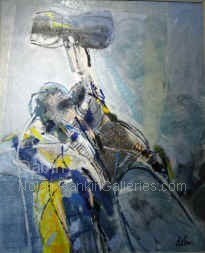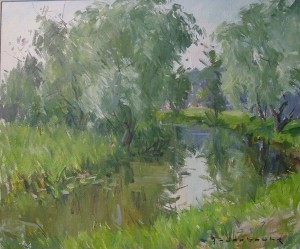with this exhibition we hope to present, at least in part, the current state of the Ecole de Paris (School of Paris) after 50 years. The whole thought of a common title for the vast group of painters was born about 1910. The description, Ecole de Paris, grew out of an attempt to explain the philosophies of the painters of the time. By this time, the Salon System of exhibitions was well established as was the grand tradition of studying with a master painter in his studio.
If the Ecole de Paris was born in 1910, how can we be looking at a 50th Anniversary? It normally takes an author to define the elements or members of a group. The history of modern painting had been well documented by World War II. What was chaotic after the war, however, was the situation for the artist and the dealer. Both artist and dealer were scattered about the globe without any idea of how to rebuild an art community in Paris. Galerie Charpentier came up with the concept of a huge exhibition in Paris of all the contemporary painters and primary artists of the established School of Paris. The idea was simple, the task huge and the results remarkable. The events that followed helped locate many of the painters, open the markets again to dealers, reinforce the dormant salons and unify this vast group once again. This was not just a single exhibition but a series of exhibitions, which took place over several years.
With this effort came writer Raymond Nacenta, who compiled the text for Ecole de Paris (Editions Seghers Paris), which was later translated and published by the New York Graphic Society. The book gives an overview of painters since 1860, from Impressionism to the Post war period. With the exhibitions and the compilation of the painters came the rebirth of the Ecole de Paris in the 1947-48 season. What made the exhibitions more significant was the inclusion of Le Salon de la Jeune Peinture (Salon of the Young Painters) in the overview of the current state of the school. The inclusion of the young painters was an attempt to include artists who would be important to the school in the decades to come.
The Ecole de Paris was born at a time when Paris was ripe with writers and intellectuals. The great painters of the Impressionist movement had already seen their renegade style not only accepted as mainstream but a stepping stone to the Fauvist, Cubists and Expressionists. There was at this time a growing paradox of two co-existing thoughts: the avant-garde and the traditionalist. The art world was in for a shock from an unexpected source: Russia. In 1911 Paris welcomed the Ballet Russe, and ensemble of painters, dancers, musicians, composers and poets creating color in motion. We must credit the Ballet Russe for creating an incomparable atmosphere of artistic expression. By 1917, even Picasso was designing for the second Inaugural of the Ballet, and Paris was the ideal climate for artistic growth.
In this atmosphere came the capital idea of change for the painter, whereby viewing the painting with conceptual subjectivity replaced the painting as “an open window on nature.
For a fraction of contemporary art, the object of beauty is no longer the feeling, but the cause of that feeling, to say, the work.
The Ecole de Paris, or the idea we hold of it is born of multiple resources. Since Vuillard and Bonnard, witness the “belle époque” through Bernard Buffet, witness to a harder world, 40 years have passed.
From the School of Paris (1960)
The Painters and the Artistic Climate of Paris Since 1910
By Raymond Nacenta
Already we mix dates and theories that have become blurred, but the work is there. Co-existing are the Fauvists, Cubists and all of the foreign painters who arrived to become the Ecole de Paris; a marvelous multifaceted diamond. The brilliance, the invention, the polish and the joy characterized by the diverse artistic foundation is unique in the world.
Paraphrased from the School of Paris (1960)
The Painters and the Artistic Climate of Paris Since 1910
By Raymond Nacenta
But the painters also held that to go forth one had to look at the painters before them which continued to reinforce the studio system of work with the master painter.
By the time Nacenta began compiling the Ecole de Paris he had the luxury of time to reflect.
Our exhibition presents some of the artists who were included in these exhibitions and a few of the painters they have influenced.
| Note: Jean Jansem and Claude Venard were included in the original exhibition at the University of Southern Illinois at Carbondale and are not currently represented by Nolan-Rankin Galleries. These short biographies were included in the original exhibition catalogue. |
Jean Jansem Born 1920 in Seulejze, Armenia.. Came to Paris in 1931 and studied at the “Ecole des Arts Decoratives” and the “Beaux-Arts de Paris”. His paintings are in the collection of the City of Paris, the State of France, numerous foreign museums and two museums in Japan dedicated only to his works. Among the pieces included will beCircus Circa 1980 , Parade of Revelers with Donkey Mask, Young Girl with Green Stockings and selected drawings. |
Michel-Henry Born in Langres, France 1928. Studied at the “Ecole Nationale Superieure des Beaux-Arts de Paris”. He rapidly became head of the studio of Roger Chapelain-Midy. He has been awarded the Chevalier dans l’Ordre National de la Legion d’Honneur. He is committee chairman and member of all the major salons. His paintings are in numerous museums including the Musee d’Art Moderne de Paris , Museum of Bogata….etc.  |
Paul Ambille1930 – 2010 Born in Beziers, France 1930. Studied at the “Ecole Nationale des Beaux-Arts” and in the studios of Dupas, Legueult and Goerg. In 1955 he won the Premier Grand Prix de Rome. He is President of Honor of the Artistes Français, Administrator of the Artistic Advisory Committee of the Minister of Cultural Affairs and a member of the acquisition commission for the government of France. He is the current president of the prestigious Foundation Taylor. His paintings are in the collections of the State of France and the City of Paris as well as numerous museums. . |
|
|
|
Marcel Mouly1918 – 2008 Born in Paris, 1918 – 2008. His primary studies are at the Montparnasse 80 of Paris with Andre Auclair. In 1938 he was called into military service. Serving in the Navy, began his love of marine themes. In 1940 he was arrested and imprisoned at Fresnes by the Germans as a spy. He was released in 1941 and was befriended by Pignon and Lipchitz and took residence in their studios. His mentor Burtin encouraged him to submit to the Salon of Young Painters and one of his first presentations was purchased by the French government. His paintings are now in numerous museums including new museums in Shanghai and Hong Kong. Over 20 museums list his work in 12 countries.  |
|
|
|
|
|
Joël Dabin1933 – 2003 Born in Pallet, Loire- Atlantique, 28 February, 1933 – 2003. He was a member of the “Demain Groupe” with Ambille, Le More, Journod. & Berdal. This French Figurative Modern artist was a regular participant in all the major salons. His paintings were purchased by the City of Nantes, City of Paris, Musee Nanves-Fondation Lafont, Museum of Fontenay-le-Comte and the Museum of Sables-D’Olonne. He had major one-man exhibitions in France, United States, Belgium, Holland, Germany, Switzerland, Japan, Tahiti, Great Britain, Canada, and the former Soviet Union. |
|
|
|
|
Monique Journod Born in Rome, 1935. She has a diploma of the Ecole Nationale Superieure des Beaux-Arts of Paris and studied in the studio of Chaplain-Midy. She won the Prix de Rome in 1962. She is a member of the “Demain Groupe” and the Foundation Taylor. Among her numerous awards she has received are the Gold and Silver Medals of the Salon des Artists Français and the prestigious Medal of Honor of the same salon. Her works are in numerous museums. Included in the exhibition areBouquet, and Brittany Harbor (Salon of Automne painting 1993). |
|
|
|
|
| Marko Stupar Born in Yugoslavia, 1936. Studied at the Beaux-Arts of Belgrade. Moved to Paris in 1964 and was immediately accepted by his peers to regularly participate in all of the major salons. He has won both the Gold and the Silver Medals of the Salon des Artistes Français. Museums include the Museum of Issy-les Moulineaux; Museum of Bosnia, Sarajevo; Museum of Modern Art, Paris; Museum of Banja-Luka; and the Museum of Bihac. |
|
|
|
|
Renée Théobald Born in Paris. Studied at the Sorbonne and the Ecole des Beaux-Arts, Paris. She exhibits at all of the major salons of Paris and has received numerous awards including the Silver medal of the Salon des Artistes Français and the City of Tours. The city of Paris has three of her paintings in their collection as does the City of London. Her first American exhibition was at the prestigious de Young Museum of San Francisco. |
|
|
|
|
| Claude Venard Born in Paris, March 21,1913. Studied at the Beaux-Arts of Paris. Participated in the Ecole de Paris exhibitions at Galerie Charpentier and the exhibition of the Young French painters at the Whitney Museum, New York. His group exhibitions include the Düsseldorf Museum with Bernard Lorjou and Bernard Buffet. Included among the museums with his paintings are the Museum of Modern Art, Paris; The Tate Gallery, London; Museum of Montreal, Canada; Museum of Dusseldorf, Germany; Museum of San Paulo, Brazil; Museum of Bale, Switzerland ; Munich, Germany; Museum of Tokyo, Japan; Dallas Museum, TX . | |
|
|
|
|
Paul Jean Anderbouhr1909 – 2006 Born in Paris, September 23, 1909 – 2006. Studied in the studios of Adler and Berges. Recognized as an impressionist with expressionistic overtones, he had his first one-man exhibition (one of eleven such shows) with the prestigious Gallery Durand-Ruel. He divided his time between France and Morocco. In 1998, Galerie Mazarine dedicated to only his work opened in Paris with a permanent collection of his paintings on display. |
|
|
|
|
|
Michèle LelloucheBorn in Tunisia, now residing in Paris. Studies include the Beaux-Arts of Tunis, Paris, and the Acadamie de Port-Royal. Studied with the masters: Marzelle, Ravel, Claude Schurr and Le More. Participates in all of the major salons of Paris and is the recipient of the Fondation Taylor Award, the Grand Prize of the Academy. |
|
|
|




